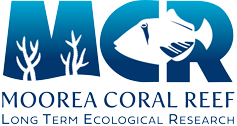Year:
2025
Authors:
Source:
M.S. Thesis
Abstract:
Scleractinian corals from areas with high environmental heterogeneity such as daily temperature range (DTR) have shown increased physiological tolerance to thermal stress. It has been hypothesized that acclimatization to DTR can act as a thermal priming mechanism, in which the exposure to an environmental stimulus can alter an organism's response to a subsequent environmental stimulus. The extent to which DTR can modify coral physiology has potential impacts on future coral community composition, as well as the persistence of coral reef ecosystems. Chapter 2 of this thesis examines the potential for DTR to act as a thermal priming mechanism by measuring the response of maximum quantum yield (Fv/Fm) and growth rate of corals collected from sites with contrasting DTRs (0.52ºC vs. 0.84ºC) to a high temperature treatment. In August 2023, a two temperature mesocosm experiment was conducted with Porites rus and massive Porites spp., testing the acclimatization of corals to higher magnitudes of DTR (0.84ºC vs. 159ºC). The response of Fv/Fm to high temperature was both DTR and species specific, with P. rus from the high DTR site showing greater reductions in Fv/Fm ¬ in high temperature than P. rus from the low DTR site. In contrast, massive Porites spp. from the high DTR site showed no reduction in Fv/Fm in high temperature compared to conspecifics in the same treatment. In chapter 3, the capacity for corals to rapidly acclimatize to different magnitudes of DTR was tested by measuring the effect of increasing DTR (no DTR, 2.34ºC DTR, 3.75ºC DTR) on the ∆F/F'm, growth rate and aerobic respiration of Acropora hyacinthus over 18 days. ∆F/F'm values of corals incubated in high DTR showed significantly lower values than other treatments after 24-hours but recovered to near control values by the end of the 18-day experiment. This thesis examines the physiological mechanisms behind tropical coral acclimation to DTR, and if DTR can act as a thermal primer for subsequent high temperature. A field contrast of DTRs were tested through the response of corals to high temperature, before DTR was experimentally manipulated to examine coral physiological acclimation to these regimes. This research highlights the acclimation of photophysiology to high magnitudes of DTR, highlighted through both lack of reduction to Fv/Fm of P. rus in high temperature in chapter 2, and the quick (18 days) recovery of ∆F/F'm of A. hyacinthus in chapter 3. The impact of DTR acclimatization on the survivorship of coral reefs in the Anthropocene will depend on if physiological acclimatization has positive impacts on coral fitness.
Publication Type:
Thesis or Dissertation
Publisher:
Department of Biology, CSU Northridge



